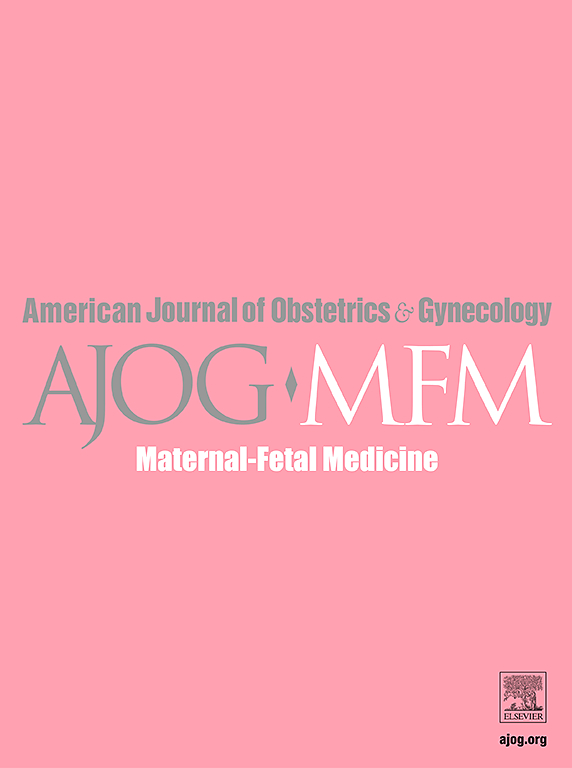Maternal and neonatal outcomes after delayed vs early cord clamping at cesarean delivery: a systematic review and meta-analysis
IF 3.8
2区 医学
Q1 OBSTETRICS & GYNECOLOGY
American Journal of Obstetrics & Gynecology Mfm
Pub Date : 2025-04-18
DOI:10.1016/j.ajogmf.2025.101680
引用次数: 0
Abstract
OBJECTIVE
This study aimed to systematically review maternal and neonatal outcomes after delayed cord clamping compared with early cord clamping at the time of cesarean delivery.
DATA SOURCES
MEDLINE, Embase, and ClinicalTrials.gov were searched from inception through October 5, 2023.
STUDY ELIGIBILITY CRITERIA
Our population included childbearing people undergoing cesarean delivery, and neonates delivered via cesarean delivery after 23 weeks of gestation. Our intervention was delayed cord clamping (>30 seconds after birth) compared with early cord clamping. Randomized controlled trials and prospective and retrospective comparative studies were included.
METHODS
Abstracts and potentially relevant full-text articles were doubly screened, and accepted articles were doubly extracted. Of the 736 abstracts screened, 222 full-text articles were assessed, and 25 studies were included. Fifteen studies reported maternal outcomes, 20 reported neonatal outcomes, and 10 assessed both neonatal and maternal outcomes. Data were extracted by 9 reviewers, and PRISMA (Preferred Reporting Items for Systematic Reviews and Meta-Analyses) guidelines were followed. Random-effects meta-analyses of pooled proportions were conducted. Maternal outcomes included were estimated blood loss, postoperative hematocrit reduction, total surgical time, postpartum hemorrhage, blood transfusion, uterotonic administration, postoperative hemoglobin reduction, and incidence of hysterectomy. Neonatal outcomes included bilirubin levels, hematocrit change, phototherapy, neonatal intensive care unit admissions, Apgar scores at 1 and 5 minutes, mean hemoglobin, cord pH, mortality, need for resuscitation, and blood transfusion.
RESULTS
No difference was noted between delayed and early cord clamping at cesarean delivery for any maternal outcome, including estimated blood loss, postpartum hemorrhage, blood transfusion, surgical time, additional uterotonic administration, change in hemoglobin/hematocrit, and incidence of hysterectomy. Delayed cord clamping was favored for neonatal hematocrit change and bilirubin levels. No difference was noted in the need for phototherapy, neonatal intensive care unit admissions, and Apgar scores.
CONCLUSION
In agreement with robust physiological evidence, our data suggest that delayed cord clamping improves some neonatal outcomes (including hematocrit and bilirubin levels) for both term and preterm infants born via cesarean delivery compared with early cord clamping, without increasing the risk of adverse maternal outcomes, including maternal bleeding.
剖宫产延迟与早期脐带夹紧后的孕产妇和新生儿结局:系统回顾和荟萃分析。
目的:系统回顾剖宫产时延迟脐带夹紧(DCC)与早期脐带夹紧(ECC)的产妇和新生儿结局。数据来源:MEDLINE, EMBASE和ClinicalTrials.gov从成立到2023年10月5日进行检索。研究资格标准:我们的人群包括接受剖宫产的育龄人群和23周后通过剖宫产分娩的新生儿。我们的干预是DCC(出生后超过30秒)与ECC相比较。包括随机对照试验、前瞻性和回顾性比较研究。研究评价和综合方法:摘要和可能相关的全文文章进行双重筛选,被接受的文章进行双重提取。在筛选的736篇摘要中,评估了222篇全文文章,并纳入了25项研究。15项研究有产妇结局,20项报告了新生儿结局,10项研究同时观察了新生儿和产妇结局。数据由9位审稿人提取,并遵循系统评价和meta分析首选报告项目(PRISMA)指南。计算合并比例的随机效应meta分析。产妇结局包括估计失血量、术后红细胞压积减少、总手术时间、产后出血、输血、子宫强张剂使用、术后血红蛋白减少和子宫切除术发生率。新生儿结局包括胆红素水平、红细胞压积变化、光疗、新生儿重症监护入院、1分钟和5分钟Apgar评分、平均血红蛋白、脐带pH、死亡率、复苏需求和输血。结果:对于产妇结局,DCC和ECC在剖宫产中的任何结局都没有差异,包括估计的出血量、产后出血、输血、手术时间、额外的子宫扩张给药、血红蛋白/红细胞压积的变化和子宫切除术的发生率。对于新生儿结局,DCC在红细胞压积变化和胆红素水平方面更受青睐。光疗需求、新生儿重症监护入院和Apgar评分均无差异。结论:与生理上强有力的证据一致,我们的数据表明,与ECC相比,DCC改善了剖宫产足月和早产儿的一些新生儿结局,而没有增加不良产妇结局的风险,包括新生儿红细胞压积和胆红素水平良好,未增加产妇出血。
本文章由计算机程序翻译,如有差异,请以英文原文为准。
求助全文
约1分钟内获得全文
求助全文
来源期刊

American Journal of Obstetrics & Gynecology Mfm
Medicine-Medicine (all)
CiteScore
7.40
自引率
3.20%
发文量
254
审稿时长
40 days
期刊介绍:
The American Journal of Obstetrics and Gynecology (AJOG) is a highly esteemed publication with two companion titles. One of these is the American Journal of Obstetrics and Gynecology Maternal-Fetal Medicine (AJOG MFM), which is dedicated to the latest research in the field of maternal-fetal medicine, specifically concerning high-risk pregnancies. The journal encompasses a wide range of topics, including:
Maternal Complications: It addresses significant studies that have the potential to change clinical practice regarding complications faced by pregnant women.
Fetal Complications: The journal covers prenatal diagnosis, ultrasound, and genetic issues related to the fetus, providing insights into the management and care of fetal health.
Prenatal Care: It discusses the best practices in prenatal care to ensure the health and well-being of both the mother and the unborn child.
Intrapartum Care: It provides guidance on the care provided during the childbirth process, which is critical for the safety of both mother and baby.
Postpartum Issues: The journal also tackles issues that arise after childbirth, focusing on the postpartum period and its implications for maternal health. AJOG MFM serves as a reliable forum for peer-reviewed research, with a preference for randomized trials and meta-analyses. The goal is to equip researchers and clinicians with the most current information and evidence-based strategies to effectively manage high-risk pregnancies and to provide the best possible care for mothers and their unborn children.
 求助内容:
求助内容: 应助结果提醒方式:
应助结果提醒方式:


